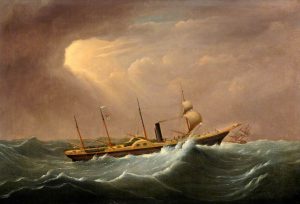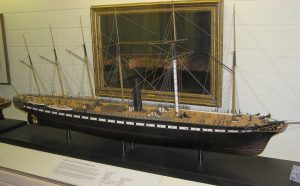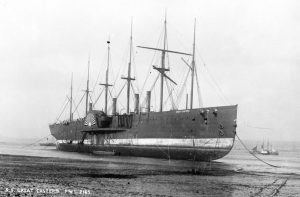Isambard Kingdom Brunel was fascinated with the idea of building steam driven metal ships that could travel across oceans. He calculated that though the volume a ship could carry was cubically proportional to its dimension, the drag it experienced was only squared. This meant that the larger a ship was, the more fuel efficient it would be proportionately speaking. Brunel put his theories into practice with the construction of the Great Western (1836), the longest steam ship at the time, powered by the common day technology of paddlewheels and sails. Brunel’s ship was in a race with the Sirius to make the first transatlantic trip on steam power alone. Unfortunately, a fire in which Isambard was injured, delayed the ship’s departure. Although the Great Western left port four days after the Sirius, she arrived in New York only one day behind and, unlike the Sirius which had to burn furniture, rope, and spars as fuel, the Great Western still had a third of her coal left over.

Brunel’s theories on the size of ships had been proven correct, and he proceeded to build the Great Britain (1843), the largest ship in the world, which was also not only one of the first screw propeller driven ships, but also had an iron hull. For combining these two technologies, it was considered the first modern ship.

Finally, Brunel built the Great Eastern (1858), nearly three times the length of the Great Western and was propelled by sails, paddle wheels, and a screw propeller. All three of these ships again gave testimony to Brunel’s genius and vision at combining and applying the technology of the day through a variety of means to bring England roaring into the modern era.

So why have I spent three post giving you a history lesson about a man who you’ve probably never heard of? In the early 2000s the BBC had a competition where they asked their public to vote for who they thought the ten greatest Britons were and they then did a one hour segment on each of them. Many recognizable names such as Newton, Shakespeare, Queen Victoria, and Churchill make the list, but Brunel who actually won second place behind Churchill is an unknown figure in America. This oversight is slightly shameful as Brunel is practically the founder of modern England and therefore by extension, America. His vision, courageously enterprising nature, and inexhaustible energy made him not only the leader, but the epitome, of the industrial revolution. Men like Brunel took on projects and works with the help of machines that had never before been tried. He had the incredible audacity to fly in the face of the limitations that man had contended with for centuries. Men like Brunel, through the industrial revolution, dramatically improved the quality of life for the average citizen. It is no wonder then that with Isambard’s resume of accomplishments and legacy that he is not only considered the greatest British engineer who ever lived but also the second greatest Briton in history.


